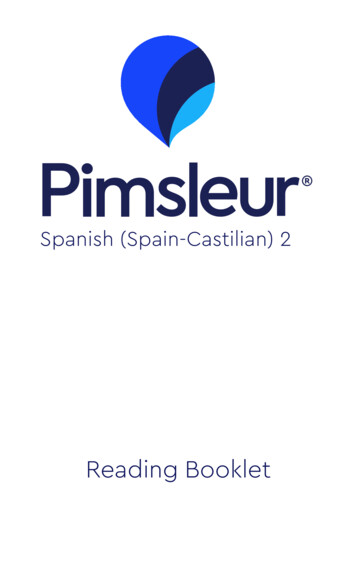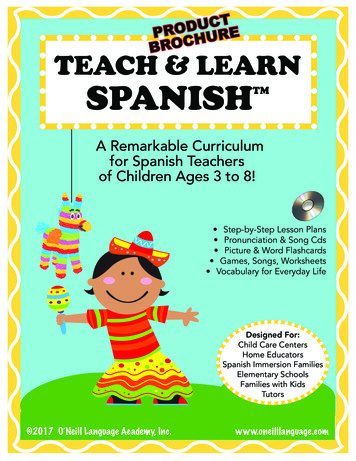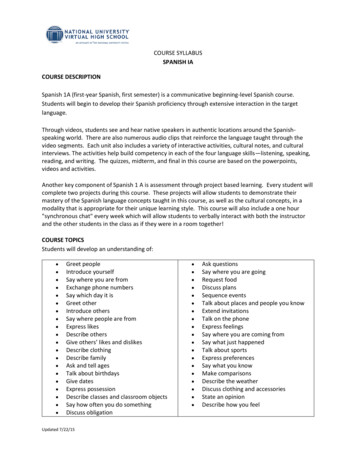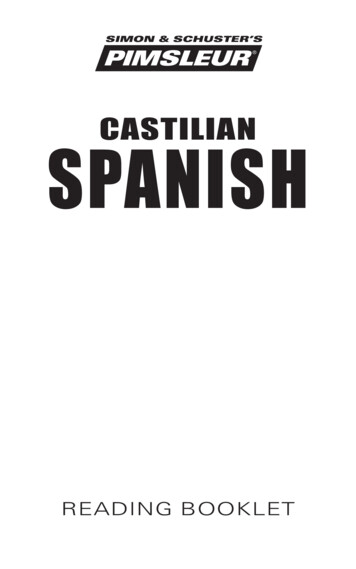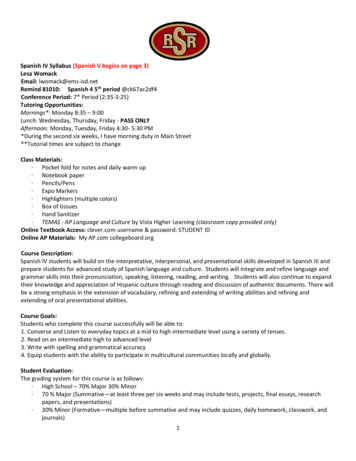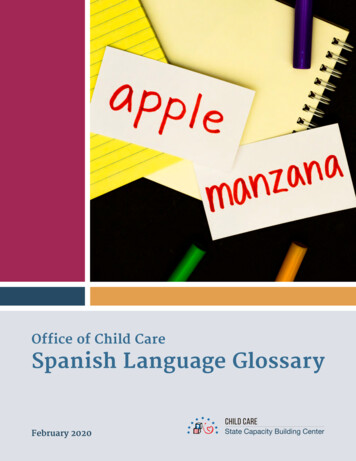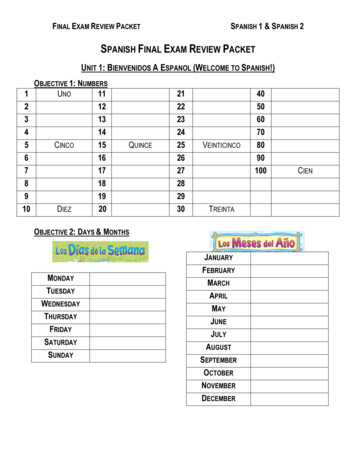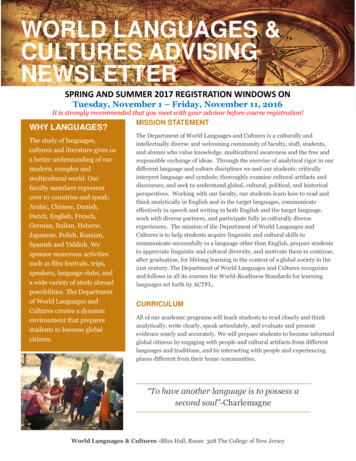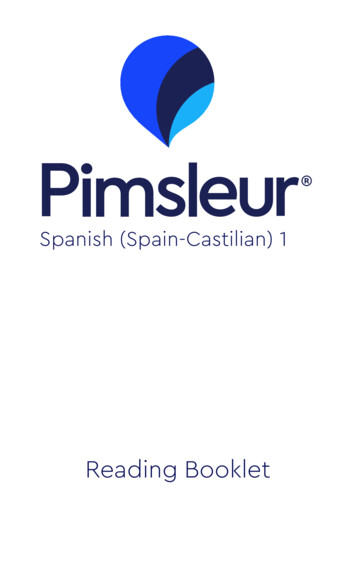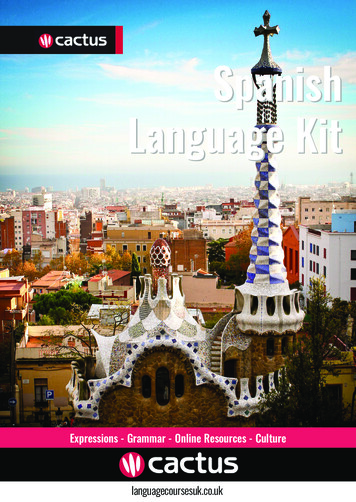
Transcription
SpanishLanguage KitExpressions - Grammar - Online Resources - Culturelanguagecoursesuk.co.uk
IntroductionWhether you plan to embark on a new journey towards learning Spanish or you just need abasic reference booklet for a trip abroad, the Cactus team has compiled some of the mosthelpful Spanish expressions, grammar rules, culture tips and recommendations. Spanish,being one of the world’s most commonly spoken languages, is a highly useful language tolearn. Knowing Spanish will enable you to fully explore Spain and Latin America, and willhelp you discover Hispanic and Latin American food, music, film and way of life. Spanish isone of the easiest languages for native English speakers to learn and it remains the mostpopular language among Cactus language learners, not least due to the high-demand forSpanish language skills in the professional world. Learning Spanish is the beginning of anexciting adventure that is waiting for you!The Cactus Team3.4.5.8.10.11.12.15.Essential ExpressionsGrammar and NumbersUseful VerbsOnline ResourcesTake a Language HolidayCultural DifferencesHispanic Culture RecommendationsStart Learning Spanish2Contact usTelephone (local rate)0845 130 4775Telephone (int’l) 44 1273 830 960Monday-Thursday: 9am-7pmFriday: 9am-5pm
Essential ExpressionsHelloGoodbyePleaseThank youYesNoExcuse me/sorryMy name is What is your name?Nice to meet youWhere do you come from?I come from Great Britain/AmericaHow are you?Where is ?I would like (2 bottles of water)How much is that?How do I get to ?I don’t understandI’m sorry, I don’t speak SpanishHola (oh-lah)Adiós (ah-dee-ohs)Por favor (por fah-bor)Gracias (grah-see-ahs)Sí (see)No (no)Disculpe/Perdone (dees-kool-peh / pehr-dohnay)Mi nombre es/Me llamo (mee nohm-breh ess/may yah-moh)¿Cómo te llamas? (koh-moh tay yah-mahs)Encantado (en-cahn-tah-doh)¿De dónde eres? (day dohn-day eh-rehs)Soy de Gran Bretaña/América¿Qué tal estás? (kay tahl ay-stahs)¿Dónde está ? (dohn-deh eh-stah)Me gustaría / ¿Me puede dar? (dos botellas de agua)¿Cuánto cuesta esto?¿Cómo puedo ir a ?No (lo) entiendo (noh (loh) ehn-tyen-doh)Lo siento, no hablo españolDo you speak English?¿Hablas inglés? (ah-blahs een-glehs)(loh see-ehn-toh noh ah-bloh eh-spahn-yol)3
Grammar and NumbersIndefinite articlesMasculineFeminineSingular Pluralel martes los martesla carta las cartasDefinite articlesSingular PluralMasculine un coche unos cochesFeminine una carta unas cartasNumbers0cero10 uline Masculine Femininesingular rossusmitusunuestravuestrasuSubject pronouns: yo, tú, él/ella/usted, nosotros/nosotras, vosotros/vosotras, ellos/ellas/ustedes20 cientosmil
Useful VerbsHablar (to speak)Comer (to resent perfecthe habladohas habladoha habladohemos habladohabéis habladohan ent perfecthe comidohas comidoha comidohemos comidohabéis comidohan blabaishablabanPluperfecthabía habladohabías habladohabía habladohabíamos habladohabíais habladohabían iscomíanPluperfecthabía comidohabías comidohabía comidohabíamos comidohabíais comidohabían laréishablaránFuture perfecthabré habladohabrás habladohabrá habladohabremos habladohabréis habladohabrán �iscomeránFuture perfecthabré comidohabrás comidohabrá comidohabremos comidohabréis comidohabrán comido5
Useful VerbsVivir (to live)Ser (to be)PresentvivovivesvivevivimosvivísvivenPresent perfecthe vividohas vividoha vividohemos vividohabéis vividohan vividoPresentsoyeresessomossoissonPresent perfecthe sidohas sidoha sidohemos sidohabéis sidohan ivíanPluperfecthabía vividohabías vividohabía vividohabíamos vividohabíais vividohabían thabía sidohabías sidohabía sidohabíamos sidohabíais sidohabían viviránFuture perfecthabré vividohabrás vividohabrá vividohabremos vividohabréis vividohabrán ture perfecthabré sidohabrás sidohabrá sidohabremos sidohabréis sidohabrán sido6
Useful VerbsEstar (to be)Ir (to ent perfecthe estadohas estadoha estadohemos estadohabéis estadohan estadoPresentvoyvasvavamosvaisvanPresent perfecthe idohas idoha idohemos idohabéis idohan stabanPluperfecthabía estadohabías estadohabía estadohabíamos estadohabíais estadohabían thabía idohabías idohabía idohabíamos idohabíais idohabían staránFuture perfecthabré estadohabrás estadohabrá estadohabremos estadohabréis estadohabrán estadoFutureiréirásiráiremosiréisiránFuture perfecthabré idohabrás idohabrá idohabremos idohabréis idohabrán ido7
Online ResourcesThere are so many free online resources that it is sometimes difficult to know which ones touse, and to identify which ones are good. Cactus has carefully assessed the wide range of freelanguage learning resources available online to provide you with a selection of our most recommended, useful and reliable sources of information for learning Spanish. These can be used asa helpful support to language learning whilst taking one of our face-to-face Spanish courses.DictionariesWordReference is a popular bilingual dictionary, and combines its own dictionary with the longestablished Collins dictionary. WordReference also includes a handy Spanish verb conjugator anda forum where users can get help with Spanish language related questions.Reverso is a well-established online bilingual dictionary. It includes an English-Spanish dictionary, along with other handy tools such as a translator and spellchecker.The Diccionario de la lengua española is the official monolingual Spanish dictionary published by the Real Academia Española. In Spanish only.Clave is a useful monolingual Spanish dictionary. In Spanish only.General resourcesThe BBC has an extensive Spanish section with grammar, vocabulary, and culture resources.PronunciationForvo is a free and comprehensive pronunciation guide maintained by native speakers around theworld. It includes the pronunciation of more than 3 million words in 325 languages.8
Online ResourcesGrammarVerbix offers a free online Spanish verbs conjugator.Aprender Español is a comprehensive website offering grammar resources and exercises. Italso has a vocabulary section along with songs and videos to help you practice Spanish.VocabularyMemrise is a popular website and mobile app which enables you to memorise Spanish vocabulary. It is a great and fun way to learn new vocabulary in addition to your language course.Language Guide is a project helping Spanish language students to build their vocabulary usingan image and sound dictionary.Quizlet is a fun and simple website and mobile app which will help you develop your Spanishvocabulary using flash cards.Cram has a large list of flash cards to help you learn new Spanish words. It also has a mobile app,so you can memorise Spanish vocabulary anywhere anytime.Mobile appDuolingo is a fun mobile app which offers a comprehensive series of vocabulary, pronunciationand translation exercises. It is a great way to practice what you learn during your Spanish evening courses while on the go.9
Take a Language HolidayTaking an immersion course abroad is a very efficient way to quickly improve your Spanish language skills. Not only it will increase your confidence in speaking Spanish, but it will also be aunique opportunity to discover and experience the culture of a Spanish-speaking country andpractice Spanish with native speakers on a daily basis. Cactus has teamed up with the bestlanguage schools across the world to offer you a first-rate language learning experience.SpainThe most popular language holiday destination among Cactus Spanish learners, Spain is also acountry with a rich culture, and gastronomy. Cactus offers immersion courses in various settingsincluding colourful and bustling cities such as Barcelona and Madrid, sunny coastal destinationssuch as Alicante, Marbella and Valencia, and stunning islands including Ibiza and Tenerife.Central America and the CaribbeanCentral America has much to offer to Spanish learners, from vibrant cities to large sunnybeaches. Cactus offers language holidays across Costa Rica, Guatemala, Mexico, and Panama. Inaddition to this, if you prefer to learn Spanish in one of the many enchanting Caribbean islands,our Spanish immersion courses can be taken in Cuba and Dominican Republic.South AmericaSpanish is the dominant language in South America, and as such Cactus offers immersioncourses in many destinations such as Argentina, Chile, Colombia, Ecuador, and Peru.10
Cultural DifferencesEvery culture has its specificities, and as fascinating as they can be, not knowing them can provesurprising and challenging when travelling. To help you blend into the local culture and makethe most of your time in Spain, we have listed some of the most striking cultural differences youshould be aware of, along with some helpful tips.TimesThe difference in terms of times between the UK and Spain can be quite challenging. It is safe tosay that everything occurs later in Spain. The famous Spanish siesta usually takes place between2pm and 4pm, and people often work until 8pm. Few shops and supermarkets are open duringthe siesta time, and you should take this into account when planning your day. Similarly, unlike inthe UK, Spanish people go out later in the night.PolitenessBritish people are notoriously polite, and not adding ‘please’ after a ‘yes’ or ‘thank you’ after a‘no’ can be seen as rude, if not offensive, in the UK. In Spain on the other hand, directness is therule, and Spanish people will not make an extensive use of ‘please’ and ‘thank you’. You shouldnot be dismayed at this, and using ‘please’ everytime could even make locals think you ‘le estástomando el pelo’, that is, you’re making fun of them.Tone of communicationSpanish people have a reputation for speaking loudly, beeping their cars and even shout fromwindows. Rather than being a sign of rudeness, this is seen as a sociable characteristic. Evenin professional situations, Spanish people can be more informal than British people would be.Don’t be put off by this, as it is part of standard Spanish behaviours and it can show friendliness.11
Hispanic Culture RecommendationsBooksThe Spanish and Latin American literature is renowned across the world and there is a variety ofgenres you can choose from to practice Spanish. It is almost impossible to make an exhaustivelist of books to read when it comes to Spanish literature, but we would certainly recommendthese for those who are learning the language: Papelucho, by Marcela Paz: these Chilean series of twelve books follow the everyday life ofPapelucho, an eight-year-old middle class boy living in Santiago de Chile. Cuentos de la selva, by Horacio Quiroga: written in 1918, this book is a collection of short stories depicting crocodiles, parrots, tigers and other animals living in the jungle in South America. El príncipe de la niebla, by Carlos Ruiz Zafón: a young adult novel taking place in a mysteriousvillage during the Second World War. You will have no trouble reading this entertaining book. El entenado, by Juan José Saer: this Argentine novel follows the adventures of a young Spanishboy crossing the ocean to explore the New World, and facing the strange habits and behavioursof the natives. A must-read if you love exotic and adventure stories.Music and FilmsThe Spanish cinema industry has been thriving with well-known filmmakers such as Luis Buñueland Pedro Almodóvar. There are many Spanish films you could watch, but as a new learner wewould recommend popular and easy-to-understand films such as: Tres metros sobre el cielo (2010): fast-paced yet predictable, this film will be easy to followfor Spanish learners. The film tells the story of a troubled teenager wreaking havoc and startinga life-changing romance with a wealthy girl.12
Hispanic Culture Recommendations El laberinto del fauno (2006): this dark fantasy film takes place in 1944, five years after theSpanish Civil War, and follows the touching story of Ofelia, a young girl living between the realworld and a mythical world. Como agua para chocolate (1992): this Mexican films spans over two decades, is about familyand traditions. Tita, the main character, cannot marry the man she loves because of traditionsand her fustration is heightened when her sister marries him in her place.Music-wise, there are many songs with Spanish lyrics you could listen to to practice your listening skills. Depending on your preferences, you may be more interested in flamenco or instead inpop. Listening to easy-to-understand song will prove more efficient for beginners and elementarySpanish learners. Here are a few we picked up for you: Agua, by Jarabe de Palo: a slow and very easy-to-understand song ideal for beginners. No me resignaré, by Binomio de Oro de América: another easy-to-understand yet with a moremoderate tempo, this love song is a good example of Vallenato, a Colombian folk music style. Carito, by Carlos Vives: while the tempo of this song is quick, it is clearly sung and its catchyrhyme will soon be stuck in your head! Olvido, by Amaral: this poetic song uses simple vocabulary and fuses several music styles intoa captivating tune.FoodSpanish and Latin American cuisine is diverse and has been shaped by various influences. Today,Hispanic gastronomy is one of the most prominent in the world. As result, it can be hard to decidewhich dish to choose from, but we thought you should taste these:13
Hispanic Culture Recommendations Gazpacho: a refreshing and chilled soup made of tomatoes, olive oil, garlic, bread, peppersand cucumber. If you are in Córdoba, then try salmorejo, the local thicker version served withIbérico ham on the top. Paella: it goes without saying you should try this famous Valencian rice dish. Served in a largefrying pan and made of various ingredients, paella is the most traditional of all rice dishes theValencian region has to offer. Tortilla de patatas (Spanish omelette): this delightful omelette simply made of eggs, potatoes and onions, slowly fried in olive oil is one of Spain’s most popular recipes. Patatas bravas: made of chunks of fried potatoes and served with bravas sauce, patatas bravas are probably the most renowned tapas. Chimichurri and grilled steak: chimichurri is a herb and garlic sauce used for grilled steaks.Originally from Argentina, this sauce has spread across Latin America. Fajitas: owing to their simplicity and good taste, fajitas have become a staple of fast foodchains, and it is easy to make your own. Turrón: this very Spanish almond nougat is traditionally consumed as a traditional Christmasdessert, although it is available all year round. Buñuelo: a fried dough ball popular in Spain, Latin America, and even outside the Hispanic world. Natillas: similar to the crème anglaise found in European countries, natillas is a custard dishwidespead in Spanish-speaking countries. In Spain, it is made typically of milk, sugar, vanilla,eggs, and cinnamon. Batido: also known as licuado, this refreshing and delicious smoothie is a widespread beveragein Mexico.14
Start Learning SpanishWith so many language learning options available ranging from evening classes to online courses,it is often difficult to know where to start your Spanish language learning journey. It’s importantto assess which type of language course or combination of courses is the most appropriate foryou. To help you make the right choice, the experts at Cactus have compared the benefits of eachalternative and provided a comprehensive list of language learning options to get you started.Language Holidays: Immersion courses are an excellent way to learn and practice Spanish on adaily basis while discovering the local culture. For more information about our language holidaysdestinations, please see page 10.Group Evening Courses: Evening classes in the UK are ideal if you want to learn Spanish afterwork or your studies. They will help you learn Spanish quickly in a sociable environment and theyoffer excellent preparation for a language holiday abroad, as they will enable you to understandthe basics of Spanish prior to your trip.Private Tuition: If you can’t fit a group language course in your schedule or you prefer to studyin your own time, one-to-one Spanish classes are the perfect solution. Cactus offers both faceto-face and Skype Spanish language lessons.TEFL (Teaching English as a Foreign Language): Living abroad is a dream that many longfor, and it is often said to be the best way to achieve fluency in a foreign language. For fluentEnglish speakers, one of the easiest ways to live abroad is by teaching English as a ForeignLanguage. You can become an English teacher abroad by taking a TEFL course with Cactus. Weoffer CELTA and Trinity Cert TESOL preparation courses across the world, including in Spain,Argentina, Chile, Colombia, Costa Rica, Ecuador, Mexico, and Peru. For more information aboutTEFL courses and advice on how to become a TEFL teacher, please visit our dedicated website, oremail us at info@cactustefl.com.15
Visit our websitesLanguage Holidayscactuslanguage.comUK Group Evening Courseslanguagecoursesuk.co.ukPrivate mContact usOur AddressTelephone (local rate)0845 130 4775Telephone (int’l) 44 1273 830 960103 Lorna RoadHoveEast SussexBN3 3ELUnited KingdomMonday-Thursday: 9am-7pmFriday: 9am-5pmlanguagecoursesuk.co.uk
It includes an English-Spanish dictio-nary, along with other handy tools such as a translator and spellchecker. The Diccionario de la lengua española is the official monolingual Spanish dictionary pu-blished by the Real Academia Española. In Spanish only. Clave is a useful monolingual Spanish dictionary. In Spanish only. General resources
